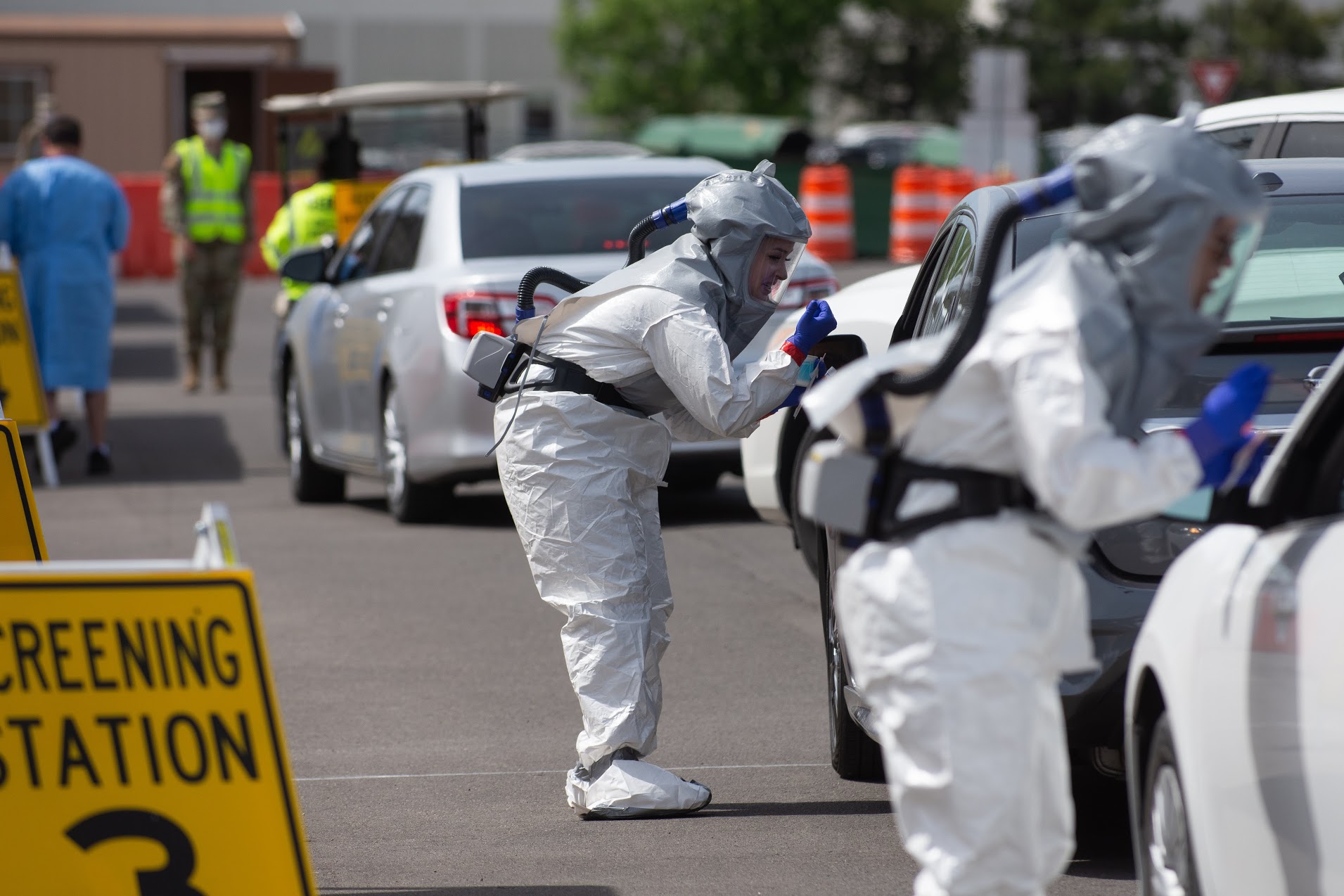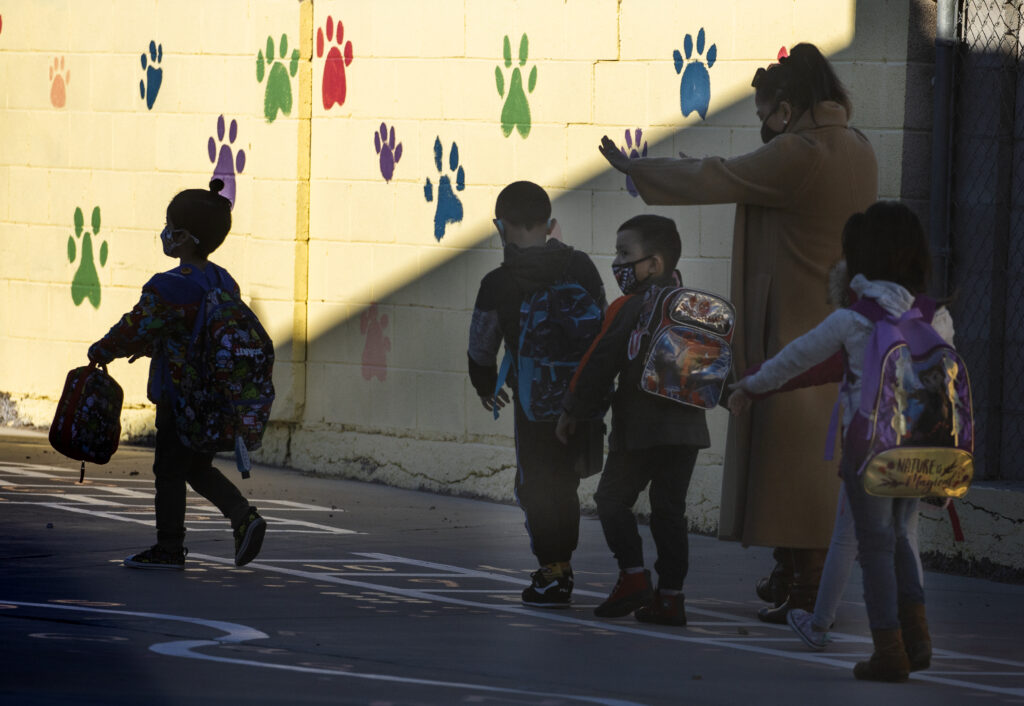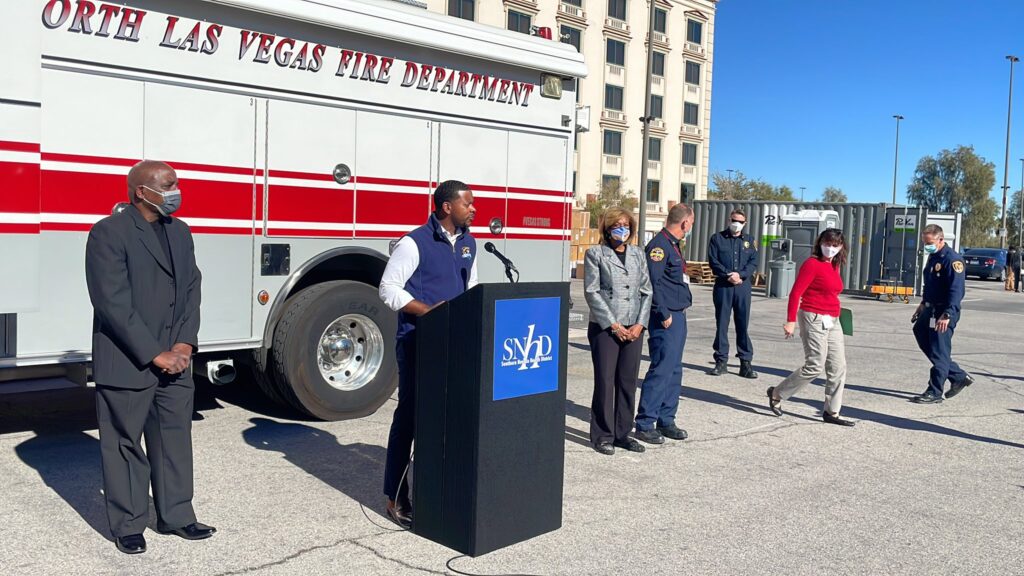COVID in Context: School staff shortages and the science of Omicron’s spread

Welcome to COVID in Context, where staff at The Nevada Independent provide context and clarity on what’s happening with COVID-19 in Nevada.
Thursday, in the wake of increased demand for testing, Gov. Steve Sisolak announced that the state is set to receive more than 580,000 at-home test kits by the end of the month. Despite record-shattering levels of positive cases, the governor said he is not considering tightening or adding COVID-19 mitigation measures. He added that he is disappointed in a U.S. Supreme Court ruling blocking the Biden administration’s vaccine mandate and weekly testing requirement for large businesses. For full details, read Jazmin Orozco Rodriguez’s story on our site.
In this edition, you’ll find a write-up of an interview with Nevada State Public Health Laboratory Director Dr. Mark Pandori answering reader questions, a look at what’s behind a ballooning number of staff absences in the Washoe and Clark County school districts as well as information on new testing sites added by the Southern Nevada Health District.
“News you can use” and “what we’re reading” near the bottom of the page also contain helpful links and resources.
COVID in Context will change depending on the situation at hand. If you have any questions, thoughts or suggestions, please reach out to tabitha@thenvindy.com or direct message her on Twitter.
Have questions about COVID-19, vaccines or the pandemic? Please submit them here so we can try and get them answered by experts in future editions.
For daily updates check out our constantly updating data page and follow @nvindycovidbot on Twitter.
— Tabitha Mueller
***
Understanding the numbers
Since our last edition of COVID in Context, increasing cases of COVID-19 in Nevada have continued to break records set the previous week in both Washoe and Clark counties and led to a five-day closure of Clark County schools.
Driving that rapid increase in COVID-19 cases across the state and country is Omicron, a coronavirus variant that spreads very rapidly, but may be less severe than other strains. The COVID-19 Omicron variant now makes up 92 percent of cases in Clark County.
As of Thursday, 6,040 new cases were reported on average each day over the previous seven days, up from 3,206 last week. That number is significantly greater than the highest point of the summer Delta wave, 1,226, which the state hit on Sept. 13.
To gain some insight into what we’re seeing, The Nevada Independent’s multimedia editor Joey Lovato and I interviewed Nevada State Public Health Lab Director Dr. Mark Pandori on Wednesday, posing reader-submitted questions about mask recommendations, severity of virus strains and efficiency of the COVID vaccine.
Though reported cases of COVID-19 are breaking records, Pandori said the actual number of cases is likely higher than reported totals for several reasons, including:
- lack of reporting of at-home test results
- asymptomatic individuals not realizing they are sick
- an ongoing testing crunch that may dissuade people from getting tested.
The state public health lab went from being able to process 90 tests a day back in March 2020 to around 3,000 tests a day now, and can handle the increased volume of testing seen in recent weeks, Pandori said. But not everyone has the same resources.
Labs able to identify COVID-19 cannot be built very quickly, Pandori said, adding that Nevada has very few of what health professionals term “high complexity labs,” which take years to construct and set up.
“Anytime you have a spike, there's a demand for testing,” Pandori said. “The testing infrastructure is relatively the same as it was a year ago. And so the demand goes skyrocketing [making it difficult to get a test]. When the demand is low, it's easy to get a test.”
Pandori said the stress on testing facilities also stems from various requirements for a negative test result to travel, show up to work or attend an event.
For individuals who are symptomatic or did test positive for the virus, Pandori said current medical research indicates that vaccinated individuals are infectious for about four or five days after catching the virus. That window expands to 10 or 11 days for unvaccinated individuals.
“It's very rare for people to be symptomatic beyond five days,” Pandori said. “To keep society together and to keep testing available to people that need it, we're using just more of a time marker to demarcate when you can go back and not necessarily a ‘you need two negative tests in a row to go back.’”
Though Pandori said it does not seem as though vaccinations are as effective at stopping infections from the Omicron variant compared to other variants of COVID-19, it does prevent serious illness.
“There's no debate on that topic. It is preventing people that do get the virus from experiencing the virus in a fatal or even severe manner,” Pandori said.
In response to questions about the severity of the Omicron variant, Pandori said he and other health care professionals are measuring case numbers against hospitalizations.
“Hospitalizations are increasing. Do not sugarcoat this, but they aren't increasing in a manner mathematically that would have matched that caseload increase compared to what we saw with something like Delta, which was truly a more virial virus,” he said.
That could indicate the Omicron variant is less severe or that increasing vaccination rates could be resulting in less severe cases. Regardless, Pandori said there is a far lower probability of intubation for people with the Omicron variant who end up in the hospital.
“I think what we're looking at here is a virus that spreads very readily, but is less virulent than previous viruses,” he said.
Pandori described other strains of COVID-19 as a cycle.
Viruses propagate by jumping from host to host, Pandori said. When a virus can’t find another host, an infected person’s immune system typically kills it off after five or 10 days, which is when people get better.
If two virus variants are circulating in a population, if one is better or faster at getting to hosts than the other, it creates what Pandori called a “dead end” for the slower virus.
“That process means that we select for only the more successful variant. When all the variants are pretty much the same at finding hosts, then they balance and bob around in equilibrium until one of them mutates into a ‘better’ version (like Delta was to Alpha and Omicron was to Delta),” Pandori said.
The Omicron variant is faster at finding hosts and most likely makes hosts less sick, so it spreads more quickly and can infect previously infected people with more ease, giving it a more extensive range of hosts to infect. It's succeeding against other virus variants that lack those advantages and are stopped by vaccinations.
What’s the result?
“It can be hypothesized, based on previous virologic studies, that the virus at the end of this rope is one that spreads like wildfire, doesn’t really make hosts that sick, and ignores as much immunity as possible,” Pandori said.
Smallpox is the only infectious disease humans have successfully eradicated. Pandori said the novel coronavirus has not gone anywhere after more than two years. He added that the virus is becoming endemic, meaning a disease that continually persists in a population or region.
“We're going to live with this virus now for quite a while,” Pandori said. “It means that the threats that you invisibly face generally in the winter time, that list of threats is now longer and there’s a new reason for you to be concerned and get a shot every year.”
But Pandori warned against trying to catch the virus deliberately and not taking precautions.
“As you host the virus, you provide the opportunity to be the mutational environment for that virus. So if everybody decided to do that, we would suddenly give the virus literally millions more rolls of the genetic dice,” Pandori said. “When you become a host, not only do you provide the genetic platform for that to change, but you provide it the jump to someone that can't afford to play that game, and that would make you an accessory to something terrible.”
Pandori said that wastewater data he analyzed indicated a likely decrease in cases of COVID-19, consistent with reports that Omicron variant cases may be headed for a rapid drop in Britain and the United States.
“I saw wastewater data yesterday out of Clark County that showed two consecutive days of extremely sharp decreases in load,” Pandori said. “I don't want to give anyone false hope. But we could probably be out of this by the end of January, in terms of the Omicron peak.”
— Tabitha Mueller

Staff absences, though not all related to COVID, balloon at schools
As the Omicron variant continued to tear through Nevada, the state’s two largest school districts faced an operational conundrum: Could they keep the doors open?
Staffing shortages caused by absences and a lack of substitute teachers have forced school systems nationwide to temporarily close or move to remote learning. By Tuesday afternoon, the Clark County School District joined the former group and announced a “five-day pause,” starting Friday and lasting through Tuesday.
The pause essentially lengthens the long weekend that includes the Martin Luther King Jr. holiday on Monday. Clark County students won’t attend school on Friday and Tuesday, and staff will work from home. Those two lost instructional days will be made up on Feb. 7 and April 25, which were previously scheduled as a contingency day and staff development day, respectively.
Clark County School District officials tied the decision to “extreme staffing shortages.”
When school resumed in Clark County on Jan. 5 — the first day of second semester — 1,643 licensed staff members were absent, a roughly 18 percent increase from the daily average of 1,396 absences so far this academic year, according to data provided by the school district. Licensed staff is a large employee cohort that includes teachers.
Those absences were not all COVID-related: Staff members may be absent for sick leave, vacation time, medical appointments, maternity leave, among other uses.
The absences for licensed staff members, however, continued to increase the next few days, peaking at 2,147 on Jan. 7. The school district reported 1,997 staff absences on Monday and 1,826 staff absences on Tuesday. Data for other days this week were not immediately available.
The district employs roughly 18,800 licensed staff members, meaning absences ranged from 8.7 percent to 11.4 percent of that employee group during Jan. 5-11.
Substitute teachers filled no more than 22 percent of the temporary vacancies created by staff absences during that same period, the district reported. As a result, schools have been combining classrooms or paying teachers to forgo their prep periods to cover classes for absent staff members, which is known as a “prep buyout.”
Additionally, the district has deployed central office staff to help lead classrooms. On Tuesday, for instance, 43 central office staff members fanned out to various schools to help alleviate staffing shortages, according to district data.
District officials have stressed that the five-day pause is more like a reset and does not foreshadow a return to distance learning.
“This five-day pause will promote a safe, healthy learning environment in our schools to ‘Stop the Spread’ in order to continue face-to-face instruction,” the district said in a statement.
In the Washoe County School District, absences for certified staff members, which includes teachers, grew from 156 on Jan. 3 to 353 on Tuesday. The absences then decreased to 314 on Wednesday and 258 on Thursday. Absences were not all COVID-related and, similar to the Clark County School District, cover a variety of reasons a staff member may not be present at school.
The Washoe County School District has 2,114 certified staff members, so at its peak on Tuesday, about 16.7 percent of those employees were absent.
Unlike its system peer down south, the Reno-area school district has not announced any temporary districtwide closures or shifts to remote learning. Instead, Washoe County School District intends to pivot to distance learning, if necessary, on a school-by-school basis.
On Thursday evening, district officials announced that Hug High School in Reno would be moved to remote learning Friday only because of staff illnesses and absences. In-person classes will resume Tuesday.
— Jackie Valley

Surging demand for testing leads to addition of temporary testing sites in Clark County
Two temporary drive-thru testing sites are opening this week in Southern Nevada with the capacity to administer 4,000 tests a day, a move officials hope will address an increasing demand for testing.
The Southern Nevada Health District along with Clark County announced Wednesday that the parking lots at Texas Station Hotel and Casino and Fiesta Henderson Hotel and Casino will operate as drive-thru testing locations for a 21-day period. The Texas Station location opened Wednesday and the Fiesta Henderson location will open on Saturday.
These additional locations supplement the Sam Boyd Stadium testing site, which has an estimated capacity of 1,200 tests per night.
There has been an increased demand for testing in the 89108 ZIP code in recent weeks that prompted the reopening of the Texas Station testing site, said North Las Vegas Councilwoman Pamela Goynes-Brown.
“We can bring testing to the community so that they're not having to drive long distances to get testing,” she said
While Omicron cases have been on the rise, Southern Nevada Health District Health Officer Fermin Leguen said he does not believe Southern Nevada has reached its peak for testing and cases yet.
“We still don't have any indication that we have reached our peak, because we are not seeing yet any tendency to plateau. That would require more than two or three days of decreasing number of cases,” Leguen said at the press conference.
— Jannelle Calderón
News you can use
Mask mandates
As of Tuesday, all counties except Eureka, Storey and White Pine counties remain subject to universal indoor masking precautions for vaccinated and unvaccinated individuals. Masks are required for unvaccinated individuals regardless of transmission rates.
Counties can have mask mandates put in place if they have two weeks of “substantial” or “high” transmission; those mask mandates will automatically be removed after two weeks of “low” transmission.
Updated masking guidelines are announced every Tuesday. For the most up-to-date information on masking mandates by county, click here.
Searching for COVID-19 testing sites?
In our edition last week, we noted the ongoing hospital staffing crisis. The Nevada Hospital Association has said that patients who want testing only will experience “excessive wait times” and anyone looking for a test should go to a testing site.
To find a testing site in Nevada, including pharmacies, head on over to the state’s COVID-19 test site finder.
For testing from the Washoe County Health District, click here.
For a complete list of testing sites in Southern Nevada, follow this link.
Trying to find an effective mask?
Since the arrival of the Omicron variant, health experts have urged Americans to upgrade their cloth masks to an N95 or KN95 because the new variant is so transmissible. These higher grades tend to be costly and difficult to find.
As this article from The Guardian explains, try to use masks that fit tightly to your face and reduce the potential for “leakage.” This guide to masks from Popular Science also has some good insight and tips when it comes to mask-wearing.
Quarantine and isolation guidelines
If you are exposed, and you don't have a positive test, the CDC is asking you to monitor your symptoms, wear a mask, and then get tested if you're symptomatic. If you are sick or test positive, the CDC recommends you stay home for five days and isolate yourself from others. You can end isolation after five full days IF you are fever-free for 24 hours without medication. Once out of isolation, wear a well-fitting mask for 10 full days when around other people.
For complete guidelines and recommendations head over to the CDC’s COVID-19 Quarantine and Isolation page.
What we’re reading
Each week, The Atlantic’s staff reporter Sarah Zhang writes about COVID-19. Her most recent piece discusses how the Omicron variant is forcing us to rethink mild COVID.
The Red Cross declared its first-ever blood shortage amid the Omicron variant surge.
This article from The Washington Post is from 2021 but feels relevant right now, especially in light of White House chief medical adviser and infectious disease expert Dr. Anthony Fauci’s statement that “virtually everybody is going to be exposed and likely get infected.”
A bit closer to home, Las Vegas Review-Journal wrote up this eye-opening story about the staffing crisis in area hospitals.
Reporter Jazmin Orozco Rodriguez is the go-to source for coverage of Nevada’s Native American and Latino communities and a must-follow on Twitter. She’s also been helping with COVID-19 coverage. Check out her latest to learn about the more than 580,000 at-home test kits Nevada is set to receive by the end of the month.
This ProPublica investigation into what happened to the billions of dollars the federal government gave schools as part of COVID-19 relief is well worth the read.
Chair of the University of California San Francisco Department of Medicine Dr. Bob Wachter shared what happened when his son tested positive for COVID in a Twitter thread. The Chronicle wrote about it.
Interesting read from Vox on rapid tests, Omicron, and you.


